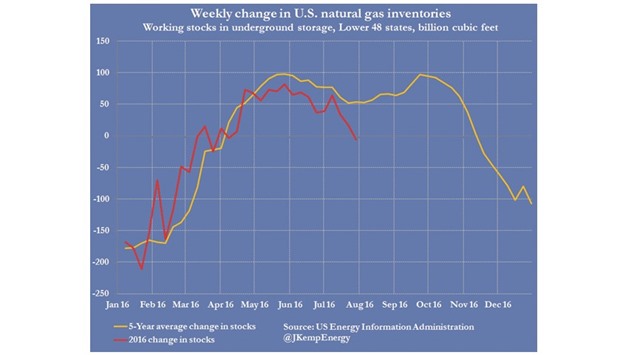Record gas consumption at power plants this summer is accelerating the rebalancing of the US natural gas market.
Working gas stocks in underground storage started the year at a seasonal record of 3,643bn cubic feet, according to the US Energy Information Administration.
Stocks were 554bn cubic feet higher than at the start of 2015.
Unusually mild weather in February and March pushed the year-on-year surplus to 1,014bn cubic feet by the middle of March.
Since March, however, the year-over-year surplus has fallen consistently as excess stocks have been drawn down by a combination of static production and strong demand from power producers.
The year-on-year surplus in gas stocks has declined every week since March 11 and was down to just 378bn cubic feet on July 29.
The underlying change has been driven by very low gas prices which caused production to level off while encouraging record consumption from power producers.
Marketed dry gas production actually fell in the three months between March and May compared with the prior year, the first annual decline since March 2013 and before that April 2010.
At the same time, gas consumption by power producers was up 7.7 % compared with the same three months in 2015.
Gas prices will need to rise over the next 12 months to curb demand growth and incentivise faster increases in supply (“US gas prices must rise to rebalance market”, Reuters, July 15).
The recent spell of hot weather has accelerated the rebalancing process by encouraging record gas combustion at power plants to meet air-conditioning demand. Temperatures have been well above normal across much of the country since the middle of May, stimulating unusually strong demand for air-conditioning.
Cumulative air-conditioning demand since the start of the year is now 2% higher than in 2015 and 11% higher than the long-term average.
Gas consumption for power generation hit a daily record 40.9bn cubic feet on July 21, according to the US Energy Information Administration (“Natural gas weekly update”, EIA, August 4).
Power producers’ gas consumption exceeded 40bn cubic feet per day on three separate days in late July.
Nine of the ten days with the highest power burn on record occurred in July 2016 (the other was in July 2015).
The result is that during the injection season, when stock would normally be increasing rapidly, stockpiles have been rising much more slowly than normal.
Stocks have risen more slowly than the five-year average every week since the start of May.
In the week ending on July 29, stockpiles actually fell 6bn cubic feet compared with an average increase of 54bn cubic feet in the last five years.
Power producers’ gas consumption is set to remain elevated in the short term which will continue narrowing the year on year surplus.
Temperatures are forecast to remain above average for the next two weeks, especially in the eastern United States.(“8-14 day outlook”, Climate Prediction Center, August 4).
Warm weather should continue tightening the market over the next fortnight and the prospect has helped push futures prices up by more than 8% from their recent low on July 21.

John Kemp is a Reuters market analyst. The views expressed are his own.


